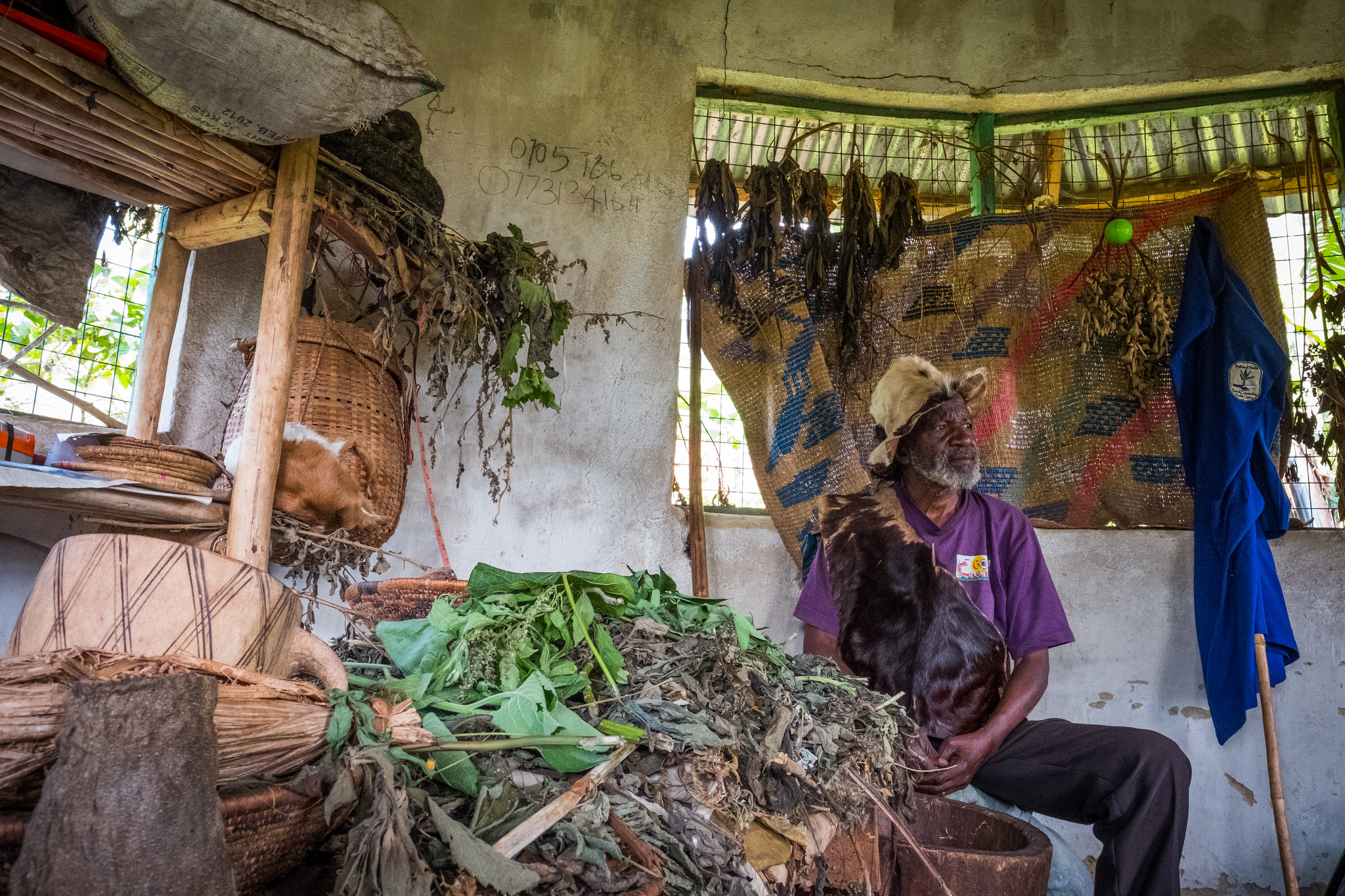A recent systematic review, published in the journal of Transcultural Psychiatry, investigates the perceptions of traditional healers and biomedical practitioners on collaborative mental health practices. The study focuses on mental health care in low and middle-income countries, where the vast majority of individuals with ‘severe mental illness’ are untreated by Western psychiatric approaches. The results of the study suggest that while each view has differing beliefs about the cause of ‘mental distress’ this difference does not impact an apparent willingness to work in collaboration. Instead, the primary barrier seems to be the limited infrastructure in place to facilitate collaborative practices.
“This paper demonstrates that, contrary to historical belief, biomedical and traditional healthcare systems are not entirely incompatible and that, when faced with a lack of resources, both biomedical and traditional practitioners have expressed a willingness to work together to provide a holistic service that reflects patient behavior, preference, and beliefs, with a shared common goal of improving patient outcomes,” write the authors, Bethany Green and Erminia Colucci from East London NHS Foundation Trust and Middlesex University, London.

The World Health Organization (WHO) has proposed that efforts to expand biomedical treatment globally should work closely with traditional or indigenous healing methods. While collaboration may pose complex challenges, it could serve as a significant improvement to the current climate of low or no access to care.
“The relationship between biomedical and indigenous forms of care has historically been tense, characterized by a belief that the two systems would not be able to work together due to their diametrically different understandings of ‘mental illness’.”
Acknowledging the ever-present reality of ethnocentric ideologies colonizing indigenous practices, the researchers highlight potential difficulties of the move toward collaboration.
“Some argue that the idea of ‘allowing’ traditional healers to practice in their native country is steeped in complex colonial rhetoric,” Green and Colucci write. “Similar criticism has been addressed to the body of global mental health research that emphasizes ‘scaling up’ services or ‘increasing mental health literacy,’ a concept that generally translates as being ‘literate in a medico-scientific system of knowledge.'”
“On the other hand, romanticizing traditional healing and delegitimizing of psychiatric treatments, many of which have significant benefits for those struggling with ‘mental illness,’ is problematic.”
Instead, a more nuanced approach, acknowledging the pitfalls of either one becoming dominant, is advised. “This paradox was summed up by the WHO, which stated that the body of work surrounding traditional healing is underlined by ‘uncritical enthusiasm or uninformed skepticism.'”
The current qualitative study aims to systematically review the literature to learn more about the perceptions of both professionals: indigenous and biomedical. Such a review can highlight current barriers to collaboration and lay the groundwork for future studies.
Green and Colucci’s search produced 1,527 articles published between the years 1999 and 2016 related to collaborative practices, 14 studies were deemed eligible and met search criteria. The 14 studies that were included in the review looked at 393 participants, including faith-based and traditional healers, psychiatrists, nurses, and other healthcare professionals. Several themes emerged from the review: recognition of the potential of healers in mental health, strategies for collaboration, and perceived barriers to collaboration.
All studies reviewed by Green and Colucci acknowledged the vital role each practice plays in addressing issues of mental health. Biomedical practitioners acknowledge the role traditional healers play as they are a “more culturally familiar psychiatric milieu” for the client and can, therefore, “comprehend the meaning of ‘mental illness’ from a perspective similar to that of the patient.”
On the other hand, traditional healers have acknowledged that certain patient behaviors may require a biomedical intervention, reflecting flexibility in both traditional and biomedical perspectives toward collaboration. However, the how of collaboration was not so clear cut. Shared spaces, co-management of patients, and an effective system of referrals were highlighted as barriers to cooperation.
“Healers tended to want a more integrated system, suggesting that access to rooms in health centers and hospitals would facilitate collaboration. Biomedical participants did not seem keen to share working spaces with healers, with one study stating that establishing joint clinics was rated lowest priority by conventional biomedical practitioners.”
“Although most participants expressed willingness to collaborate in some form, there seemed to be very few formal structures in place. Reports from traditional healers imply that instances of referring patients were one-sided.”
Further complicating the process of collaboration are shared concerns of legitimacy regarding each other’s practices.
“Biomedical practitioners frequently expressed concerns that traditional healers’ conduct fell short of ethical or professional standards.”
While opposing views on the causes of ‘mental illness’ was inevitably a barrier, it did not stand out to the researchers as the primary obstacle to collaboration.
“There was recognition by both parties that traditional and biomedical treatment could complement one another. It is obvious, however, that there are minimal structures in place to facilitate co-working.”
The balance of integrating biomedical practices and traditional healing into one collaborative system raises concerns of colonial practices, misaligned goals, and poor communication. However, if done properly, collaboration could open the door to effective and meaningful mental health care for those who need it.
In conclusion, the researchers highlight three critical factors that future research and policy work should address:
- Exploring how an effective system that allows for the shared management of patients could be built.
- Regulating and increasing the evidence base of traditional healing.
- Developing trust between and capacity of all practitioners.
****
Green, B., & Colucci, E. (2020). Traditional healers’ and biomedical practitioners’ perceptions of collaborative mental healthcare in low-and middle-income countries: A systematic review. Transcultural Psychiatry, 1363461519894396. (Link)















The future of today’s psychotherapy is aromatherapy, no matter how cruel it may seem
Report comment
“This paper demonstrates that, contrary to historical belief, biomedical and traditional healthcare systems are not entirely incompatible and that, when faced with a lack of resources, both biomedical and traditional practitioners have expressed a willingness to work together to provide a holistic service that reflects patient behavior, preference, and beliefs, with a shared common goal of improving patient outcomes.”
I’m pretty certain it’s only now that the “biomedical” practitioners are “faced with a lack of resources,” and their industry’s scientific fraud is being exposed for the world to see, that they’ve started to be willing to work with “traditional healthcare systems.”
And now that it is being exposed that the current DSM based “biomedical” model has less than zero to do with providing “a holistic service that reflects patient behavior, preference, and beliefs, with a shared common goal of improving patient outcomes.” The DSM based “biomedical” model is all about neurotoxic poisoning people for profit, not helping people. That’s why they have to force people to take their neurotoxins, which is the opposite of what should be happening in a free market system.
And I will say my self proclaimed, “holistic, Christian talk therapist” was instead a hypocritical, “biomedical,” Holy Spirit blaspheming, child rape covering up, satanist for the systemic, child abuse covering up, ELCA religion. Absolutely, she was not someone who wanted to help me. All she cared about was covering up the abuse of my child for the ELCA religion.
https://www.amazon.com/Jesus-Culture-Wars-Reclaiming-Prayer/dp/1598868330
“On the other hand, romanticizing traditional healing and delegitimizing of psychiatric treatments, many of which have significant benefits for those struggling with ‘mental illness,’ is problematic.”
Don’t forget to mention, however, the approximately 400,000,000 people who have been murdered over the past 50 years, based upon the psychiatrists’ “invalid” DSM disorders, and with their psychiatric treatments.
https://www.nimh.nih.gov/about/directors/thomas-insel/blog/2015/mortality-and-mental-disorders.shtml
https://www.nimh.nih.gov/about/directors/thomas-insel/blog/2013/transforming-diagnosis.shtml
Your neglecting to mention these 400,000,000 “mental illness”/psychiatric drug induced deaths is problematic, as well. That’s a psychiatric holocaust larger than any other in world history.
“Biomedical practitioners acknowledge the role traditional healers play as they are a ‘more culturally familiar psychiatric milieu’ for the client and can, therefore, ‘comprehend the meaning of ‘mental illness’ from a perspective similar to that of the patient.’”
But since “biomedical practitioners” can NOT bill to EVER help ANY child abuse survivor EVER, they ALWAYS misdiagnose child abuse survivors, and their legitimately concerned family members.
https://www.psychologytoday.com/us/blog/your-child-does-not-have-bipolar-disorder/201402/dsm-5-and-child-neglect-and-abuse-1
Resulting today in “the prevalence of childhood trauma exposure within borderline personality disorder patients has been evidenced to be as high as 92% (Yen et al., 2002). Within individuals diagnosed with psychotic or affective disorders, it reaches 82% (Larsson et al., 2012).”
https://www.madinamerica.com/2016/04/heal-for-life/
And the psychologists are equally as guilty of systemically covering up child abuse.
https://www.indybay.org/newsitems/2019/01/23/18820633.php?fbclid=IwAR2-cgZPcEvbz7yFqMuUwneIuaqGleGiOzackY4N2sPeVXolwmEga5iKxdo
“While opposing views on the causes of ‘mental illness’ was inevitably a barrier, it did not stand out to the researchers as the primary obstacle to collaboration.”
I just pointed out that the likely cause of most so called “mental illness” is psychiatric and psychological cover ups of child abuse. The DSM states it is ignorant of the etiologies of it’s theorized “mental illnesses.” But the psychiatric drugs do create the symptoms of the two “most serious” DSM “mental illness.” But this is largely unbeknownst to the “biomedical” DSM “bible” thumpers, since these known iatrogenic etiologies of the so called “mental illnesses” are missing from the DSM.
https://www.alternet.org/2010/04/are_prozac_and_other_psychiatric_drugs_causing_the_astonishing_rise_of_mental_illness_in_america/
https://en.wikipedia.org/wiki/Toxidrome
https://en.wikipedia.org/wiki/Neuroleptic-induced_deficit_syndrome
“In conclusion, the researchers highlight three critical factors that future research and policy work should address:
“Exploring how an effective system that allows for the shared management of patients could be built.
“Regulating and increasing the evidence base of traditional healing.
“Developing trust between and capacity of all practitioners.”
Taking an obviously bad psychiatric system, and implementing it worldwide, is one of the dumbest ideas I’ve ever heard of. The mass murdering, primarily child abuse covering up, paternalistic, psychiatric and psychological industries should be taken down, not taken worldwide.
Report comment
There is one thing I LOVE about endless studies.
The fact that everyone is confused about psychiatry.
Report comment
Well NO. Psychiatry need to be tired for crimes against humanity. It can’t wiggle its way out.. be ‘re-imaged’. The only way is for it to go is to be deleted, purged from the recycle bin and the drug crimes perpetrated against it’s victims which caused death and destruction tried in court. Two MiA activists on here have recently died at the hands of psychiatry, we can multiply that by very many thousands maybe millions. We can’t brush all this under the carpet and play pretend.. Oh well that didn’t work… Let’s do something else now.
Report comment
Oh, and since I happen to have both multiple Olympic athletes, as well as multiple Phi Beta Kappa members, in my immediate family. Yet I was defamed to my husband as having “bad genetics.” I’m pretty certain I am the proof that no one on this planet has good enough genetics for our satanic, systemic child rape covering up, “mental health” workers.
Report comment
Expanding the market of neuropsychiatric drugs, is what it’s all about. But can these low-income countries afford them, is the question most bio-psychiatrists are keen to find out.
Why not come clean, and admit biomedical psychiatry is a modern, insidious form of eugenics.
Report comment
Wow, we cocacolarised them and now we want to psychiatrise them. The aim with coca cola was to put a can of coke in the hands of every one on the planet. Now they want to put an anti psychotic in their hand that can be washed down with a coke.
Seems that they may be running out of experimental subjects in the West given their abject failure to demonstrate even the slightest gain in a scientific sense. Moving in on other less fortunate countries for these experimental subjects who can be exposed to the damages of psychiatric research minus any real ethical considerations was an obvious move.
Perhaps the traditional healers may require forced treatment if they disagree with what doctor wishes to do? I’d be real careful speaking to any mental health practitioner after being ‘verballed’ by one. The truth is anything they want it to be and has no basis in reality.
Report comment
Can psychiatry come up with any possible way to stay relevant/retain power now that it’s been exposed as completely fraudulent?
Report comment
They’ve done a pretty good job with the “scientific” smoke and mirrors job so far, and I’m guessing they will continue to do so as long as it works. Pretending to be the “scientific” voice is usually a winning play these days.
Report comment
“Can Psychiatry Incorporate Traditional Healing Practices?”
Can oil and water mix? Can pigs fly? Can I sell you a bridge in Brooklyn?
Report comment
The article fails to mention the rather uncomfortable fact (for psychiatry, anyway) that the indigenous approaches are FAR superior to anything psychiatry has to offer, if we actually care about the quality of life of the “patients.”
Report comment
We don’t, move on……. NEXT lol
Report comment
Well, WE do – but THEY (the psych profession) don’t! Obviously.
Report comment
True, I know I certainly do. I have been subjected to a ‘mock execution’ (it’s a fine line between torture and ‘coercion’ huh?) and had my wife, daughter and grandchildren threatened by a couple of hospital administrators and police for daring to complain about their practice of “spiking” their soon to be “patients” before subjecting them to 7 hours of interrogation.
They even attempted to unintended negatively outcome me in an Emergency Dept and failed, not because the authorities gave a damn, but because another doctor saw an opportunity to put a ‘crew’ in his pocket for later use. Personally he doesn’t have the stomach for it he tells me.
Will I back down? Not after hearing the stories of the “patients” I met on my journey. Sure they can be fine lines, but when hospital staff believe they have carte blanche and are distributing fraudulent documents about their conduct to lawyers AND BEING GIVEN MINISTERIAL PERMISSION TO DO SO, then the levels of abuse rise exponentially.
So much for the ‘protections’ in the Euthanasia Act. With fraud anything is possible.
I don’t know at what point this caring will stop and my life begin again. Maybe I need drugs to numb this excruciating psychological pain? A solution, let me take my care to some place it’s wanted? You mean I can have my passport back and leave? Honest I won’t tell anyone about what y’all are doing here. I’ll give y’all a written reference if ya like. Put it with the testimonies you have coerced from your ‘clients’.
Report comment